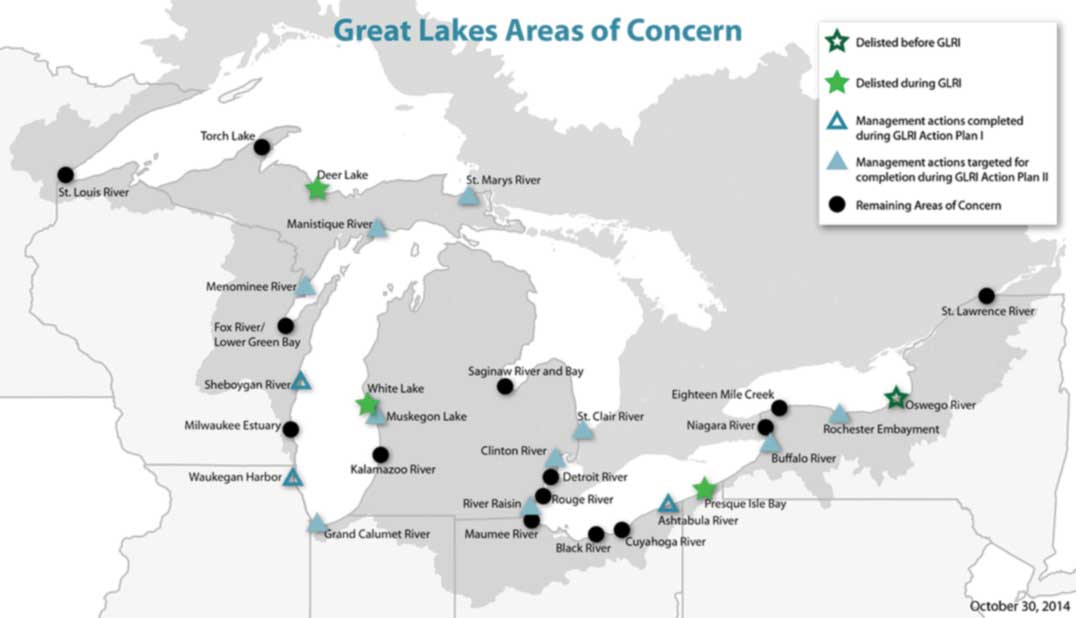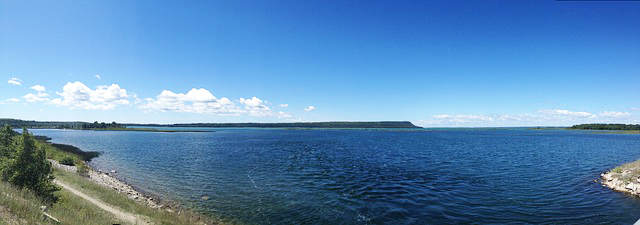LAKE HURON—According to a leaked US federal document, the Trump administration is likely to slash the Great Lakes Restoration Initiative (GRLI) budget in 2018. This news immediately follows the leaked information that the Trump administration has asked the United States Army Corps of Engineers to hold off on its continued battle to keep the invasive giant Asian carp out of the Great Lakes, specifically by not releasing details of a plan for a crucial Illinois river choke point.
The Trump administration will likely cut the GRLI’s annual funding from $300 million down to $10 million.
According to the GRLI website, the initiative was launched in 2010 “to accelerate efforts to protect and restore the largest system of fresh surface water in the world—to provide additional resources to make progress toward the most critical long-term goals for this important ecosystem.”
Through the GLRI areas of concern (AOC) are also pinpointed for specific projects on both sides of the border. In Sault Ste. Marie, the entry point of the St. Mary’s River has been noted as an AOC. Delisted AOCs on the Canadian side, thanks to funding from the GRLI, include the Collingwood Harbour, Severn Sound and Wheatley Harbour.
The total funding of America’s Environmental Protection Agency (EPA), which funds the GRLI, is also likely to see its budget slashed from $8.2 billion to $5.7 billion, according to the same documents. This would also mean a reduction of 3,000 EPA employees.
Canada’s like initiative is the Great Lakes Sustainability Fund, which has contributed around $23 million from 2006 to 2015 for Canadian AOCs.
From 2015-2019, federal agencies planned to continue to use Great Lakes Restoration Initiative resources “to strategically target the biggest threats to the Great Lakes ecosystem and to accelerate progress toward long term goals—by combining Great Lakes Restoration Initiative resources with agency base budgets and by using these resources to work with non-federal partners to implement protection and restoration projects,” the website continues.
“To guide this work, federal agencies have drafted GLRI Action Plan II, which summarizes the actions that federal agencies plan to implement during fiscal years 2015-2019 using Great Lakes Restoration Initiative funding,” the statement continues. “GLRI Action Plan II outlines the next phase of work on Great Lakes environmental problems and associated human health issues—many of which will take decades to resolve. GLRI Action Plan II lays out the necessary next steps to get us closer to the day when we will be able to achieve our long-term goals for the Great Lakes and our commitments under the U.S.-Canada Great Lakes Water Quality Agreement.”
Plan II seeks to: combat invasive species, curb nutrient-fueled algae blooms, clean up toxic messes and restore sensitive fish and wildlife habitat.
On February 13, 14 members of Congress penned a letter to President Donald Trump, noting their strong support for efforts to protect and restore the Great Lakes.
“Specifically, we respectfully request that you include $300 million for the Great Lakes Restoration Initiative (GLRI) in the Fiscal Year 2018 budget request,” they write.
“The Great Lakes are truly a national treasure. The Great Lakes are the largest freshwater system in the world, holding roughly 18 percent of the world’s fresh water supply and 90 percent of the United States’ fresh water supply. The Lakes are also an economic driver that supports jobs, commerce, agriculture, transportation, and tourism for millions of people across the country.
“More than a century of environmental damage has taken a significant toll on the Great Lakes, which the GLRI is helping to correct. Since the initiative was launched in 2010, GLRI funds have been used to support over 3,000 restoration projects to improve water quality, protect and restore native habitat, clean up environmentally-impaired Areas of Concern, fight invasive species, and prevent beach closings.
“The Great Lakes Restoration Initiative is showing real and measurable results, but there is still a great deal of work to do. The Great Lakes Basin is vulnerable to various pollutants and invasive species, which threaten the health of the Great Lakes. For example, in 2014 a toxic algal bloom in Lake Erie forced 400,000 residents in the Toledo area to go without home water service for three days. While the GLRI has prioritized monitoring efforts, which help drinking water treatment plant operators and beach managers minimize health impacts associated with these toxic algal blooms, more must be done to better understand and prevent these algal blooms in the future.
“The federal government commits significant resources each year to address the challenges the Great Lakes face. In particular, GLRI resources have supplemented agency budgets to fund coordinated efforts to protect and restore the Great Lakes ecosystem, and we must ensure that this important work continues. To that end, we urge you to include $300 million for the Great Lakes Restoration Initiative (GLRI) in the Fiscal Year 2018 budget request.”






